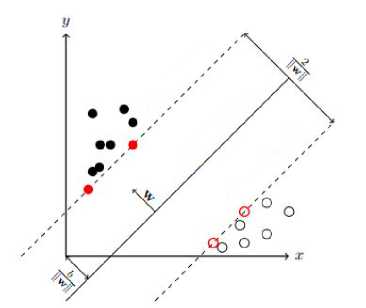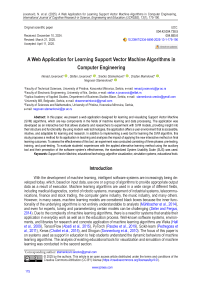A Web Application for Learning Support Vector Machine Algorithms in Computer Engineering
Автор: Nenad Jovanović, Stefan Jovanović, Srećko Stamenković, Dražen Marinković, Negovan Stamenković
Журнал: International Journal of Cognitive Research in Science, Engineering and Education @ijcrsee
Рубрика: Original research
Статья в выпуске: 1 vol.13, 2025 года.
Бесплатный доступ
In this paper, we present a web application designed for learning and visualizing Support Vector Machine (SVM) algorithms, which are key components in the fields of machine learning and data processing. The application was developed as an interactive tool that allows students and researchers to experiment with SVM models, providing insight into their structure and functionality. By using modern web technologies, the application offers a user environment that is accessible, intuitive, and adaptable for learning and research. In addition to implementing a web tool for learning the SVM algorithm, this study proposes a method for its application in teaching and analyzes the impact of applying the new interactive method on final learning outcomes. To assess the effectiveness of this tool, an experiment was conducted consisting of three phases: pre-testing, training, and post-testing. To evaluate students’ experiences with the applied alternative learning method using the auxiliary tool and their perception of the software system’s effectiveness, the standardized System Usability Scale (SUS) was used.
Support Vector Machine, educational technology, algorithm visualization, simulation systems, educational tools
Короткий адрес: https://sciup.org/170209053
IDR: 170209053 | УДК: 004.42:004.738.5; 004.855.6 | DOI: 10.23947/2334-8496-2025-13-1-175-190
Текст научной статьи A Web Application for Learning Support Vector Machine Algorithms in Computer Engineering
With the development of machine learning, intelligent software systems are increasingly being developed today, which, based on input data, use one or a group of algorithms to provide appropriate output data as a result of execution. Machine learning algorithms are used in a wide range of different fields, including medical diagnostics, control of robotic systems, management of industrial systems, telecommunications, finance and stock trading, the computer game industry, the music industry, and many others. However, in many cases, machine learning models are considered black boxes because the inner functionality of the underlying algorithms is not entirely understandable to analysts ( Mühlbacher et al., 2014 ), and even for experts, tuning and parameterizing certain models can be challenging ( Zeiler and Fergus, 2014 ). Due to the complexity of machine learning algorithms, there is a need for systems that enable their application in everyday work as well as in the education process. Well-known software systems, environments, and libraries for research and concrete application of machine learning algorithms are Weka ( Hall et al., 2009 ), TensorFlow ( Abadi et al., 2015 ), PyTorch ( Paszke et al., 2019 ), Scikit-learn ( Pedregosa et al., 2011 ), Keras ( Chollet et al., 2015 ), and Shogun ( Sonnenburg et al., 2010 ). The focus of this paper is on systems used as support in education to help students understand the dynamic behaviors of machine learning algorithms. The analysis of existing educational tools for visualization and simulation of machine learning was conducted in the second section.
-
*Corresponding author: stamenkovic.srecko@gmail.com

© 2025 by the authors. This article is an open access article distributed under the terms and conditions of the Creative Commons Attribution (CC BY) license ( https://creativecommons.org/licenses/by/4.0/ ).
The goal of machine learning is to construct algorithms capable of learning to predict specific target outputs. To achieve this, the learning algorithm is given specific training examples that demonstrate the target relationship between input and output values. The algorithm should generate approximately correct output, including examples that it did not encounter during training. For a good understanding of these topics, undergraduate students need to master other areas of computer engineering, and it is desirable to have some prior knowledge, which is often not acquired at previous levels of education ( Çağlayan, 2019 ). Therefore, it is very important to properly motivate students to learn these topics. Some of the pedagogical methods recommended for teaching machine learning are hands-on tasks, collaborative learning, and problem-based learning ( Hazzan and Mike, 2023 ). Hands-on tasks involve engaging students in real hands-on projects that include data collection, model training, and performance evaluation. This encourages practical application and solving the set tasks. Through the analysis of real problems, Problem-Based Learning helps students develop critical thinking and practical problem-solving skills. Collaborative learning allows students to solve problems together, share ideas and learn from each other. Computer engineering continuously strives for innovations in pedagogical methods and tools, especially in the field of machine learning. Auxiliary software tools should enable students and future engineers to visualize and simulate different algorithms for educational purposes and to gain insight into the possible effects of certain algorithms, thus more easily selecting the appropriate algorithm for specific needs and optimally determining the parameters with which to use the appropriate algorithms through simulation.
Rutten et al. (2012) considered a large number of experimental studies on the effects of software tools in teaching published over a decade. Many studies reviewed in that work compare working conditions with and without auxiliary tools, showing positive results in favor of using software tools to improve traditional learning methods. Today, it is common to use different learning support tools in computer engineering courses during laboratory exercises. In courses more oriented towards studying hardware and abstract systems, such tools are often software simulators ( Djordjevic et al., 2005 ; Jovanovic et al., 2012 ; Stamenkovic and Jovanovic, 2024 ) whose task is to simulate the system being studied. In software courses, tools for visual representation of algorithms are often used ( Thakur et al., 2011 ; Stamenkovic et al., 2023 ). The field of designing tools for the visual representation of algorithms has a long tradition, and many such software systems have been realized so far. Interpreting machine learning models is currently a popular topic in the information visualization community, and the results demonstrate that insights from machine learning models can lead to better predictions and improved reliability of results ( Chatzimparm- pas et al., 2020 ). With the growing popularity of machine learning, there is also a greater need for systems for the visual representation of algorithms in this field.
Support Vector Machine (SVM) is one of the fundamental algorithms in the field of machine learning, and understanding it is crucial for a deep comprehension of the theoretical and practical aspects of this field. Support Vector Machines (SVM) are powerful machine learning algorithms used for classification, regression, and anomaly detection ( Cortes and Vapnik, 1995 ; Bennett and Campbell, 2000 ; Schölkopf and Smola, 2002 ). The idea of the method is to find a separating hyperplane in the vector space where the data are represented so that all data from the same class are on the same side of the plane, as shown in Figure 1. SVM finds the optimal separating hyperplane, which is the plane with the maximum margin. The margin represents the width of the separation between classes that should be maximized. SVM algorithms are characterized by their ability to effectively work in high-dimensional spaces and with data that are not linearly separable due to the use of kernel functions. Since SVM effectively classifies multidimensional data of various types, it is successfully applied in various fields, including biosciences for analyzing biological processes, medicine for analyzing medical images, DNA analysis, and predicting population structure. It is also widely used for classifying hate speech on social networks. Due to their wide application and significance, SVM algorithms are an integral part of university course literature on machine learning.

Figure 1. An example showing the optimal hyperplane with the maximum margin that separates data into two classes
The aim of this study is the development of a web application that serves as an educational tool for learning and visualizing the principles and applications of SVM algorithms. The application is developed using modern web technologies such as HTML-CSS, JavaScript, and Java EE technologies, enabling interactive and visual learning. The use of these technologies contributes to the flexibility and accessibility of the application, making it available to a wide range of users, including students and researchers.
The paper is systematized into seven sections. Following the introduction, the second section analyzes relevant literature to present existing solutions in this field. The third section describes the system architecture with an emphasis on modular design, integration with databases, and how SVM processing is performed within the application. A detailed description of the user interface, with examples of how users interact with the application, including the visualization of SVM models, is presented in the fourth section. The fifth section presents a case study that precisely describes the strategy for learning the SVM algorithm using the developed auxiliary tool. The sixth section provides a detailed description of the conducted experiment and the results of the tool evaluation, along with a discussion. Conclusions and suggestions for future work are presented in the seventh chapter.


